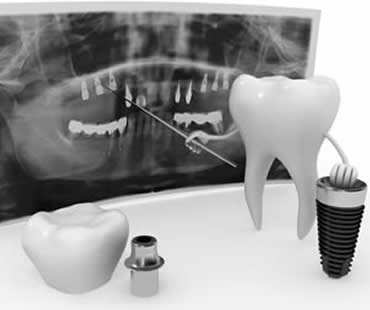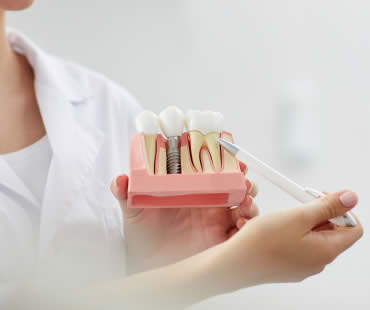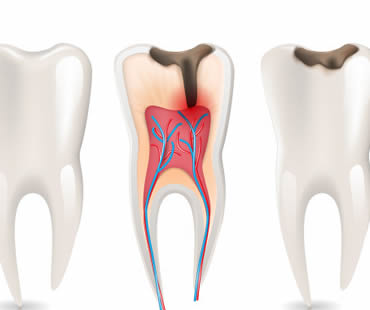
Dental implants are the state-of-the-art restorative solution for missing teeth. They provide a stable base that is the next best thing to a natural tooth root. Because of this and other qualities, dental implants are rising in popularity each year as more and more people discover their convenience and stability.
Dental implants are replacement teeth, typically made of porcelain or a similar material, mounted on top of a titanium screw that is embedded into a patient’s jawbone. Over time, this screw will fuse directly with the bone in a process known as ossification. This fusion creates a tooth base that is so stable, it’s as good as a tooth’s natural roots.
Dental bridges can become dislodged and food may collect under the bridge, leading to discomfort and bacteria build-up. A dental implant goes all the way down, so there’s no “under” underneath to collect food and cause problems.
Most tooth restorations necessitate special ways of cleaning or flossing, and you have to be careful you’re doing all the right things to maintain your teeth properly. You care for a dental implant the same way you do for a natural tooth, by brushing and flossing, so you don’t even have to think about it when you’re cleaning your mouth.
The bones in your jaw are only healthy as long as you have healthy tooth roots in them. The tooth roots stimulate the bone, signaling it to stay full and healthy. Without the stimulation of the roots, the bone begins to shrink away. Dental implants preserve bone by acting as artificial tooth roots. The jawbone can’t tell the difference, and the bone stays strong and robust.
These factors and more are leading patients to turn to dental implants to address their missing teeth. Talk to your cosmetic dentist to see why dental implants are the perfect choice for you.
Do not wait any longer. Book your appointment now and achieve the smile you have always wanted. Dr. DiStefano is accepting new patients from Longview and the surrounding area.

Treatment with dental implants has proven to be highly predictable, with success rates in the range of 95%. However, if you are considering the placement of dental implants, you may still want reassurance about the safety of implants and the surgical procedure.
Dental implants are utilized to replace missing or damaged teeth. The implant acts in place of the natural root and supports restorations such as crowns, bridges, or removable dentures. Once implants have been placed, the patient enjoys the benefit of an appliance that looks and feels like natural teeth. Dental implant surgery is performed with the patient under local or IV sedation. The implant takes approximately four to six months to fuse to the jawbone, at which time your permanent restorations can be put into place.
We offer Dental Implants in Longview
In the past implants have been known to shrink the bone surrounding the implants over the course of time. However, newer implant technology has eliminated this risk almost completely. Implants also do not damage the surrounding teeth during preparation.
Titanium is the most common material for dental implants. This type of metal is known for outstanding resistance to corrosion, as well as being highly compatible with the environment within the mouth. While allergic reactions to titanium are possible, it is known to be extremely rare.
The best insurance you can give yourself regarding implant safety is to take time and care when choosing your oral surgeon. A highly skilled and experienced doctor will be better prepared about how to avoid or treat potential complications. A good oral surgeon will take great care in the planning stages of your implant surgery to avoid the possibility of implant failure.
Once your surgery is complete, it is vitally important to follow all the post-operative and aftercare recommendations your oral surgeon provides. Do not skip or postpone your follow-up visits, and maintain excellent oral hygiene to ensure you will escape any potential risks or complications and enjoy the benefits of dental implants for many years.

More and more patients with missing teeth are taking advantage of the popular restoration method of dental implants. If you are considering implants, you might have some questions or concerns. It may sound like a daunting procedure that might scare you off, but getting the facts will likely ease your fears.
We offer Dental Implants in Longview
How will I know about the process?
Seeking treatment from a qualified, experienced, reputable dentist is the first step in the dental implant process. If you and your dentist decide together that implants are a good solution for you, dental X-rays will be taken to get a clear picture of your bite and exactly where the dental implant should be placed. With the appropriate data and information needed, your dentist will create a treatment plan for accurately inserting the implant during oral surgery and later placing a crown on top to complete the restoration. These initial steps in the process will help avoid complications during the implant procedure.
Does it hurt?
If pain is what’s making you hesitate about getting dental implants, the good news is that there is practically no pain during the procedure. You will remain comfortable during treatment thanks to simple anesthesia injections in the area. Although you may notice vibrations during implant placement, actual pain shouldn’t occur. Anti-anxiety medications are sometimes given to calm a patient’s nerves, and sedation dentistry is an option for those with more serious dental fears.
What about recovery?
Most patients experience minimal pain after dental implant surgery. Soreness is normal, similar to what you’d expect after getting a filling, but over-the-counter medication like ibuprofen is usually sufficient. Dentists sometimes prescribe an antibiotic or a mouth rinse to reduce infection risks during healing. With the advancements made in dentistry, there is no reason to shy away from dental implants. Make a dental appointment in our Longview office to learn more about them today.

Over time, daily life can take a toll on your smile. Decay, breakage, disease, and missing teeth can negatively affect your mouth. Restorative dentistry focuses on repairing damage and renewing the integrity of your smile. With today’s advanced technology and high-quality materials, you can enjoy strong, attractive restorations. Don’t put off necessary dental work any longer.
Common restorative procedures include:
Composite fillings
To repair teeth damaged brought on by decay, your dentist will likely choose an all-white filling. Tooth-colored fillings produce solids restorations that blend in with your natural teeth and allow for less removal of healthy tooth structure.
Dental Crowns
When you have a larger area of decay than a regular filling can fix, your dentist may suggest a dental crown. Also called a cap, a dental crown covers the area above the gum line, re-establishing the strength and appearance of the injured tooth. Usually, it takes two visits to receive your custom crown. During the first appointment, your dentist will remove the decay, take impressions for the crown, and fit you with a temporary. You will return for permanent placement a few weeks later.
Dental Implants
If you have lost teeth, your oral health and self-esteem may suffer. Dental implants can replace one or more missing teeth, giving you back a complete smile. Dental implants include a metal post that functions as an artificial tooth root and a prosthetic crown that is cemented on top to complete the restoration.
Porcelain Veneers
Often considered a cosmetic choice, porcelain veneers can also cover chipped or broken teeth. Made from fine dental porcelain, veneers are permanently attached to front teeth, creating a flawless image. Your dentist will select the right veneers to fit your features, personality, and budget.
Do you live in Longview or the surrounding area? Our team is ready to help you achieve your smile goals. Schedule your appointment today.

One thing that can make an entire family smile is good oral health. When everyone has healthy teeth and gums, there is more reason to show off those great smiles. Oral health issues can even run in families, so taking care of a problem in one person may help other family members as well by alerting them to the condition. Family dentists can benefit everyone in your household. This type of dentist treats all family members, no matter what their age is. Young children, teens, adults, and seniors are all treated in one dental practice. Family dentistry focuses on taking care of the oral health needs for everyone in the family, and offers a variety of benefits by doing so.
Establishing a healthcare relationship with a family dentist means that everyone goes to the same office for appointments. The dentist and staff get to know each person, and can provide a level of comfort knowing that everyone is receiving the same standard of care. Family dentists understand your needs and those of other family members too.
Family dentists are trained and experienced in providing care for all kinds of issues. This always includes routine dental care like cleanings, fluoride treatments, sealants, and fillings. Some family dentists also perform procedures like implants, veneers, bonding, contouring, root canal treatments, and even orthodontics. You should choose a family dentist who offers services that meet the needs of every family member.
Another thing that family dentists are skilled in is teaching patients the best ways to care for their own oral health. Children may need to be taught how to properly brush and floss, teenagers might need reminders about consistent care or maintenance with braces, and adults often require special attention for good gum health. Seniors face unique challenges related to maintaining their oral health in order to keep their natural teeth. Family dentists understand the needs of patients at each stage of life, and can provide optimum treatment for those specific challenges.
Your smile is one of your most valuable assets and your oral health should not be compromised. Finding a good family dentist is your first step in the right direction.
Take the first step towards optimal oral hygiene. Reserve your dental appointment at our Longview dental office now and experience personalized care.

There are many misconceptions about root canal treatment. This process is recommended when your tooth pulp is infected or damaged, and the treatment is needed to save your tooth. The damaged pulp is removed from your tooth and filled with a material that prevents future infections. A crown is often recommended to be placed over the tooth to complete the procedure and preserve the tooth. If your dentist recommends this treatment for you, it may save you some worry if you know the truth about the procedure.
Truth about the pain
Root canal treatment has advanced over the years, making it much less painful than its previous reputation. Anesthesia is used during the procedure, and most patients say it is no worse than getting a filling.
Truth about office visits
The procedure can usually be completed in just one or two office visits. Several factors impact the number of appointments, such as the extent of infection, complexity of the procedure, and need for referral to a different health care professional. Your dentist will be able to advise how many office visits are needed for your treatment.
Truth about symptoms
Your tooth does not absolutely have to be painful to indicate the need for a root canal. A dentist may diagnose a serious problem even when you don’t feel discomfort. That’s one reason regular checkups are important, so that issues can be caught.
Truth about cause
It is a myth that root canal treatment is caused by illnesses like heart disease, arthritis, or kidney disease. Medical research has proven these long-time myths to be untrue.
Truth about success
The benefits of root canal treatment can last a long time, even permanently. Sometimes patients experience broken teeth after treatment, but dentists attribute this to failure in the restoration or tooth construction instead of the root canal treatment itself. Patients who do not opt to get crowns tend to experience tooth breakage more often.
Take the first step towards a confident smile. Contact our Longview dental office to schedule your consultation!









